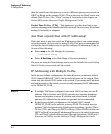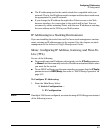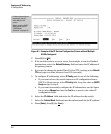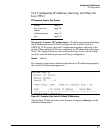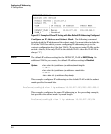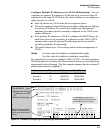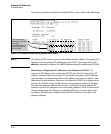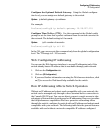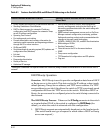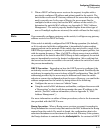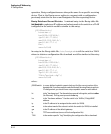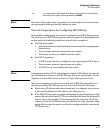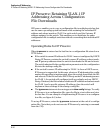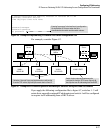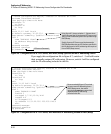
8-12
Configuring IP Addressing
IP Configuration
Table 8-1. Features Available With and Without IP Addressing on the Switch
DHCP/Bootp Operation
Overview. DHCP/Bootp is used to provide configuration data from a DHCP
or Bootp server to the switch. This data can be the IP address, subnet mask,
default gateway, Timep Server address, and TFTP server address. If a TFTP
server address is provided, this allows the switch to TFTP a previously saved
configuration file from the TFTP server to the switch. With either DHCP or
Bootp, the servers must be configured prior to the switch being connected to
the network.
The DHCP/Bootp Process. Whenever the IP Config parameter in the switch
or in an individual VLAN in the switch is configured to DHCP/Bootp (the
default), or when the switch is rebooted with this configuration:
1. DHCP/Bootp requests are automatically broadcast on the local network.
(The switch sends one type of request to which either a DHCP or Bootp
server can respond.)
Features Available Without an IP Address Additional Features Available with an IP Address and
Subnet Mask
• Direct-connect access to the CLI and the menu interface.
• Stacking Candidate or Stack Member
• DHCP or Bootp support for automatic IP address
configuration, and DHCP support for automatic Timep
server IP address configuration
• Spanning Tree Protocol
• Port settings and port trunking
• Console-based status and counters information for
monitoring switch operation and diagnosing problems
through the CLI or menu interface.
• VLANs and GVRP
• Serial downloads of operating system (OS) updates and
configuration files (Xmodem)
•Link test
• Port monitoring
• Password authentication
• Quality of Service
• Authorized IP manager
• Web browser interface access, with configuration,
security, and diagnostic tools, plus the Alert Log for
discovering problems detected in the switch along with
suggested solutions
• SNMP network management access such as ProCurve
Manager network configuration, monitoring, problem-
finding and reporting, analysis, and recommendations for
changes to increase control and uptime
• TACACS+, RADIUS, SSH, SSL, and 802.1X authentication
• Multinetting on VLANs
• Stacking Commander*
• Telnet access to the CLI or the menu interface
•IGMP
• Timep server configuration
• TFTP download of configurations and OS updates
•Ping test
*Although a Commander can operate without an IP address, doing so makes it unavailable for in-band access in an IP
network.



